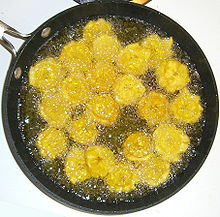Deep frying
Deep-frying or frying is a cooking method related to frying, in which food is fried while floating in hot fat. Unlike frying, deep-frying heats the food primarily by conducting heat over the entire surface. This is comparable to boiling, but the much higher temperatures of 140 to 190 °C result in the formation of a dry crust and aromatic roasting substances (Maillard reaction).
For deep-frying, suitable fat with a high smoke point, vegetable oil, lard or clarified butter, is heated to just below the smoke point in a pot or special deep-fryer and the food is added. If the fat is not hot enough or cools too much by adding too much cooking, the pieces will soak up fat before a crust can form. The rapid transfer of the highest possible temperature to the surface of the food to be cooked largely prevents its penetration, for then the water vapour from the food to be cooked, developed by the high temperature, flows towards the penetrating fat. This effect is even more pronounced in industrial vacuum fryers.
The water vapour on the surface of the fat prevents oxygen from reaching the hot fat, which is why fat that is constantly used to prepare fried food oxidises more slowly than fat that is heated or kept warm without fried food. On the other hand, foods rich in water (French fries, meat dishes, etc.) lead to faster fat spoilage than foods poor in water (e.g. doughnuts).
The temperature should not be too high, as acrylamide, which may be harmful to health, can be formed more frequently at over 175 °C. At very high overheating (>200 °C), the highly toxic acrolein may also be formed. Bioluminescent and histological studies in a mouse model of late-stage breast cancer showed that feeding thermally abused frying oil (TMF) resulted in a significant increase in metastatic lung tumor formation compared to feeding fresh soybean oil. In addition, metastatic tumors in the lungs of animals consuming the TMF treatment diet showed a 1.4-fold increase in the Ki-67 marker of cell proliferation, and RNA-sequencing analysis of liver tissue revealed diet-induced modulation of gene expression in the liver. The thermally abused oil used in this study contained approximately 15 percent polar material (TPM value), which are chemically modified triglycerides and fatty acids used as chemical markers for oil degradation. Fresh oil contains 2-4 percent or less polar material. The maximum polar content set by regulations in EU countries is in the range of 16 to 27 (Germany 24) percent. This can be reached in restaurant use in two to three days. When fats are heated, numerous decomposition products are formed, such as conjugated fatty acids, polymerized triglycerides and their degradation products (free short-chain fatty acids, mono- and diglycerides, aldehydes, ketones, polymers, cyclic and aromatic compounds), which can lower the smoke point, make the fat more viscous and give it a soapy or scratchy taste. Severe overheating also promotes the risk of a grease fire, which can cause severe scalding and cannot be extinguished with water. Spoiled deep-frying fat and foods prepared with it are a health hazard and cannot be marketed. It is a punishable offence to place such foodstuffs on the market.
Chemically, fat spoilage oxidizes the reactive double bonds of the long-chain unsaturated fatty acids, breaking or polymerizing the long molecular chains.
Frying fat that is not overheated can be used more than once, provided it is filtered to remove impurities that reduce the smoke point and develop bitterness. It should be noted, however, that the fat often takes on the flavour of the food prepared in the first frying operation and this can be transferred to the food cooked in the second frying operation.
Foods that are particularly rich in starch, such as potatoes and other firm vegetables, as well as pastries, are suitable for deep-frying. Meat or fish, on the other hand, are often breaded or coated in batter, as they themselves contain hardly any carbohydrates. Pieces should not be too large or as flat as possible so that they are cooked inside when the surface is browned. They should (apart from batter) be as dry as possible on the surface so that the fat does not splatter and cool too much.

Frying plantains
Search within the encyclopedia